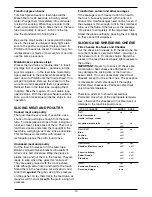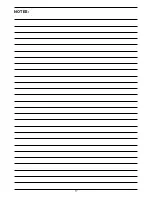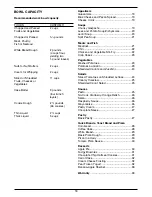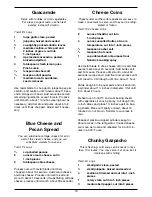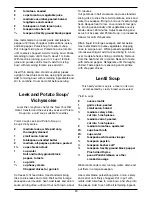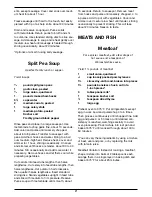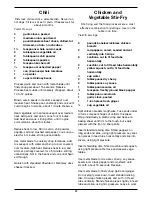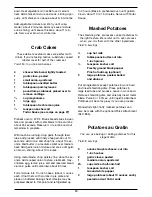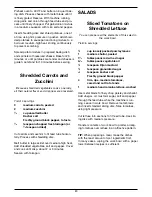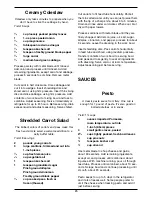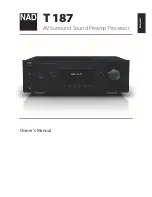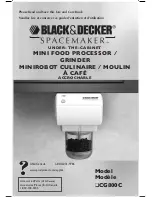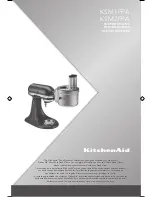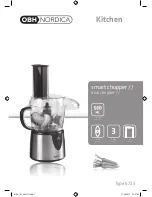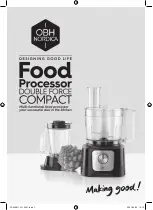
10
onto the side of the work bowl. Remove the
blade, and use the spatula to scrape any remain-
ing batter from the bowl.
TECHNIQUES FOR KNEADING
YEAST DOUGH
The Pro Custom 11
™
Food Processor can mix and
knead dough in a fraction of the time it takes to
do it by hand. You will get perfect results every
time if you follow these directions. NEVER TRY
TO PROCESS DOUGH THAT IS TOO STIFF TO
KNEAD COMFORTABLY BY HAND.
There are two general types of yeast dough.
1. Typical bread dough
is made with a flour mix
that contains at least 50% white flour. It is uni-
formly soft, pliable and slightly sticky when prop-
erly kneaded. It always cleans the inside of the
work bowl completely when properly kneaded.
2. Typical sweet dough
contains a higher
proportion of sugar, butter and/or eggs than
typical bread dough. It is rich and sticky, and
it may not clean the inside of the work bowl. It
requires less kneading after the ingredients are
mixed. Although 30 seconds is usually sufficient,
45 seconds gives better results if the machine
does not slow down. Except for kneading,
described below, the processing procedures are
the same for both types of dough.
Machine capacity
Typical bread dough:
4 cups all-purpose flour
3 cups whole-grain flour
Typical sweet dough:
3 cups all-purpose flour
If a bread dough recipe calls for more than the
recommended amount of flour, mix and knead it
in equal batches.
Always push the blade down as far as it will go on
the motor shaft.
Measuring the flour
It’s best to weigh it. If you do not have a scale, or
the recipe does not specify weight, measure by
the “stir, scoop and sweep” method. Use a stan-
dard, graduated dry measure, not a cup for liquid
ingredients. With a spoon or fork,
stir
the flour
in its container. With the dry measure,
scoop
the
flour so it overflows. With a spatula, knife or chop-
stick— being careful not to press down —
sweep
excess flour back into the container so the top of
the measure is level.
Proofing the yeast
The expiration date is marked on the packages.
To be sure your yeast is active, dissolve it in a
small amount of warm liquid (about 1⁄3 cup for
one package of dry yeast). The temperature of
liquids used to dissolve and activate yeast must
be between 105°F and 110°F. Yeast cells are not
activated at temperatures lower than this, and
they die when exposed to temperatures higher
than 130°F. If the recipe includes a sweetener
like sugar or honey, add a small amount with the
yeast. If no sweetener is called for, add a pinch.
The yeast proofs better with it. Allow the mixture
to stand until it foams — up to 10 minutes.
Processing dry ingredients
Put the flour and other dry ingredients in the work
bowl. If the recipe calls for herbs, oil or solid
fats like butter, add them with the flour. Turn the
machine on, and allow to run for about 20 seconds.
Adding liquids
All liquid should be added through the feed tube
while the machine is running. Add liquid in a
slow, steady stream, only as fast as dry ingre-
dients absorb it. If liquid sloshes or splatters,
stop adding it, but do not turn off machine. Wait
until ingredients in bowl have mixed, then add
remaining liquid slowly. Pour liquid onto dough as
it passes under feed tube opening. Do not pour
liquid directly onto bottom of work bowl.
Follow the recipe carefully. It is important to add
enough liquid to make the dough soft enough to
knead. Kneading dough that is too stiff can strain
the machine. All liquid
except
that used to acti-
vate yeast should be cold, to minimize the pos-
sibility of overheating the dough. You must never
knead a yeast dough to a temperature higher than
100°F. Doing so will slow or even prevent the
action of the yeast.
Kneading bread dough
Do not try to use the machine to knead dough
that is too stiff to knead comfortably by hand.
Doing so can strain the machine.
Kneading typical bread dough
After the dough starts to clean the inside of the
work bowl completely and forms a ball, process it
for 60 seconds to knead it. Stop the machine and
test the dough to be sure it’s properly kneaded.
Typical bread dough should have a soft, pliable
texture and it should feel slightly sticky. Stretch
the dough with your hands to test it. If it feels
Summary of Contents for PRO CUSTOM 11 DLC-8S
Page 17: ...17 NOTES ...
Page 35: ...35 NOTES ...














